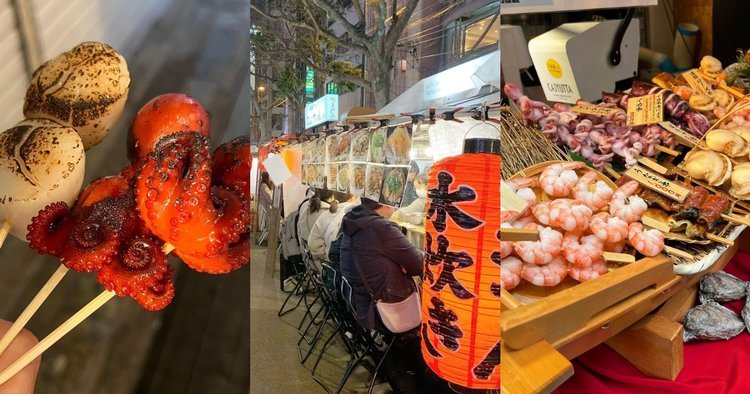How Japanese Street Food Captures Local Flavors
- By -Maria Mash
- Posted on
- Posted in Food
Japanese street food offers a vibrant and diverse array of flavors, reflecting the rich culinary traditions and regional specialties of Japan. Street vendors and food stalls across the country showcase a variety of dishes that capture the essence of local ingredients and cooking styles. From bustling city streets to traditional festivals, Japanese street food provides an authentic taste of Japan’s culinary landscape.

Regional Specialties: A Taste of Local Flavors
Japanese street food varies significantly across different regions, with each area offering its own unique specialties:
- Osaka: Known as the “Kitchen of Japan,” Osaka is famous for its street food, particularly takoyaki and okonomiyaki. Takoyaki are savory octopus-filled balls of batter cooked in a special pan, while okonomiyaki is a savory pancake made with a variety of ingredients like cabbage, pork, and seafood, topped with a tangy sauce and bonito flakes.
- Kyoto: In Kyoto, street food often features traditional and seasonal ingredients. Yudofu (tofu hot pot) and matcha (green tea) desserts are popular choices. Kyoto’s street food often emphasizes delicate flavors and presentation, reflecting the city’s historic and cultural heritage.
- Hiroshima: Hiroshima is renowned for its unique style of okonomiyaki, which includes layers of noodles, cabbage, and other ingredients cooked together on a griddle. Hiroshima-style okonomiyaki offers a hearty and satisfying street food experience.
Seasonal Ingredients and Festivals
Japanese street food is deeply influenced by seasonal ingredients and festivals. Seasonal festivals, or matsuri, are celebrated with special street food offerings that highlight ingredients at their peak:
- Summer Festivals: During summer festivals, you’ll find refreshing treats like kakigori (shaved ice) flavored with sweet syrups and fresh fruit. Corn on the cob grilled over an open flame and skewered meats are also popular at these events.
- Winter Festivals: In colder months, street vendors offer warming dishes such as oden (a hot pot stew with various ingredients) and takoyaki. These hearty foods provide comfort and warmth during chilly weather.
Traditional Cooking Methods
Street food vendors often use traditional cooking methods that enhance the flavors and textures of their dishes:
- Grilling: Grilled skewers, or yakitori, are a popular street food item. Chicken, beef, and vegetables are skewered and grilled over charcoal, imparting a smoky flavor that enhances the taste.
- Frying: Tempura and korokke (croquettes) are deep-fried street food items that feature a crispy exterior and tender interior. The use of light batter and high-quality oil ensures a satisfying crunch and flavorful taste.
- Pan-Frying: Okonomiyaki and takoyaki are prepared on griddles or special pans, allowing for even cooking and a crispy texture. These methods contribute to the distinctive taste and texture of these popular dishes.
The Role of Street Food in Japanese Culture
Street food plays a significant role in Japanese culture, offering more than just a quick meal. It is an integral part of social gatherings, festivals, and local traditions. Street food vendors often create a sense of community and connection, serving as gathering spots for locals and visitors alike. The experience of enjoying street food in Japan goes beyond the food itself, encompassing the lively atmosphere, cultural exchange, and the opportunity to taste authentic regional flavors.
Modern Trends in Japanese Street Food
While traditional street food remains popular, modern trends are also shaping Japan’s street food scene:
- Fusion Cuisine: Some street food vendors experiment with fusion dishes that blend Japanese flavors with international influences. For example, you might find sushi tacos or ramen burgers that combine traditional ingredients with innovative concepts.
- Health-Conscious Options: As health-conscious eating becomes more prevalent, some vendors are offering lighter and healthier street food options, such as vegetable-based snacks and low-oil cooking methods.
- Gourmet Street Food: Gourmet street food has gained popularity, with vendors creating upscale versions of classic dishes using high-quality ingredients and refined techniques.
Conclusion
Japanese street food captures the essence of local flavors through its diverse regional specialties, seasonal ingredients, and traditional cooking methods. It reflects Japan’s rich culinary heritage and provides a unique and authentic taste experience. Whether enjoyed at a bustling festival or a quiet street corner, Japanese street food offers a delightful and flavorful journey through the country’s vibrant food culture.



